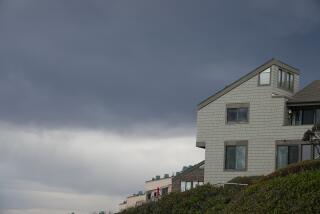After cutting back flights, airlines may soon hike fares
With summer over and vacation travel done for the season, the recession-battered airline industry took stock in the last week or so and found scant signs of improvement.
Here’s a rundown of the major findings:
* Pent-up passenger demand and cuts in airline capacity could lead to fare increases of as much as 6% globally and 7% in North America, according to the American Express Global Business Travel Forecast, which was released this week. Ancillary fees -- those charges to check an extra bag, change a flight or order a cocktail, among other costs -- are also expected to inch up, raising the overall cost of a domestic business trip by 1.2% to an average of $1,080, according to the report.
* International demand for air travel was down 1.1% in August compared with the same month in 2008, an improvement to the 2.9% decline in July, according to the International Air Transport Assn., the trade group that represents about 230 airlines worldwide.
To cut costs, airlines have reduced capacity by parking planes and cutting back on flights. Because of such changes, flights were, on average, 80.9% full in August compared with 79.7% full during the same month in 2008, according to the association.
“Demand continues to improve but profitability remains ever distant,” said Giovanni Bisignani, director general of the association.
* U.S. airlines with scheduled passenger flights employed 5.9% fewer workers in July than in July 2008, the 13th consecutive month of job cuts in the industry, according to a report released last week by the U.S. Bureau of Transportation Statistics.
The biggest percentage drop took place at Northwest Airlines, with a 12.5% cut in full-time employees, according to the bureau. Northwest was acquired last year by Delta Air Lines, which is now integrating the two airlines’ operations.
Meanwhile, Virgin America, the low-cost airline that launched in 2007, increased the number of full-time equivalent employees by 20.4% over the 12-month period ending July.
* Airline passenger revenue fell 21% in August compared with the same month in 2008 -- the 10th consecutive month of losses from the prior year, according to a study by the Air Transport Assn. of America, a leading U.S. airline industry group. In August, 6% fewer passengers traveled on U.S. airlines compared with the same month last year, while the average cost to fly dropped 17% year-over-year.
“While there are signs that improvement may be on the horizon, regrettably the demand for air travel remains weak,” association President James C. May said.
Using airline Wi-Fi has its risks
Despite slumping revenue and demand, airlines have been moving quickly to install wireless Internet in planes, giving travelers the freedom to surf the Web while soaring the skies. Perhaps the push has something to do with the service fee that airlines are charging -- a fee that increases with the length of the flight.
But now Internet security experts say business travelers who use airline Wi-Fi networks may be vulnerable to airborne hackers.
The danger comes when business travelers sign on to what they think is the airline’s wireless service and begin to exchange vital business information with colleagues on the ground.
Dave Ostrowski, security portfolio manager for IBM, said security experts have been hearing online chatter among computer hackers about new ways to use stolen information from airline passengers.
Under one scenario, hackers can get onboard a flight with a device that creates a rogue Wi-Fi network. When passengers turn on their laptops, their computer finds a Wi-Fi signal in range that appears to be operated by the airline, Ostrowski said. Hackers can then read and upload the digital communications made by passengers who sign onto the bogus Wi-Fi signal, he said.
More sophisticated hackers may even be able to use the same rogue network to access information on the laptops of passengers who sign into the system, he said.
The goal for hackers is to comb through the transmissions to pick up bits of data that could lead to a financial windfall, such as Food and Drug Administration clinical trial results or advance news on mergers or acquisitions. The airline hackers target flights popular with corporate executives, such as early-morning flights between the nation’s financial centers -- New York and Los Angeles or Chicago and San Francisco, Ostrowski said.
To protect against such schemes, Ostrowski urges Wi-Fi users to keep security and anti-virus software updated, use encryption technology to scramble outgoing data, use code words when discussing sensitive information and refrain from using “trigger terms” that hackers will look for, such as merger or acquisition.
A spokeswoman for Aircell, the largest provider of airline Wi-Fi service, said she has heard of no such problems on airplanes.
“We are no less secure than a Starbucks’ hot spot,” said Brenda Chroniak, a spokeswoman for Aircell, which operates Gogo Inflight Internet for AirTran Airways, Virgin America, Delta Air Lines and American Airlines.
Ostrowski agreed that the Wi-Fi networks on airlines are just as secure as those on the ground. But he said hackers have an easier time targeting business travelers with juicy information on a plane than in a neighborhood coffee shop.
“What’s more dangerous is the proximity to hackers,” he said. “An airplane can be a convergence point for wealthy and fruitful targets.”
Flying with their eyes wide shut
Next time you settle down into an airplane seat and find the passengers next to you snoozing away, consider this: A recent survey of more than 400 business travelers by Egencia, a corporate travel management company, found that 15% of business travelers pretend to sleep to avoid unwanted chatter with fellow passengers.
--







